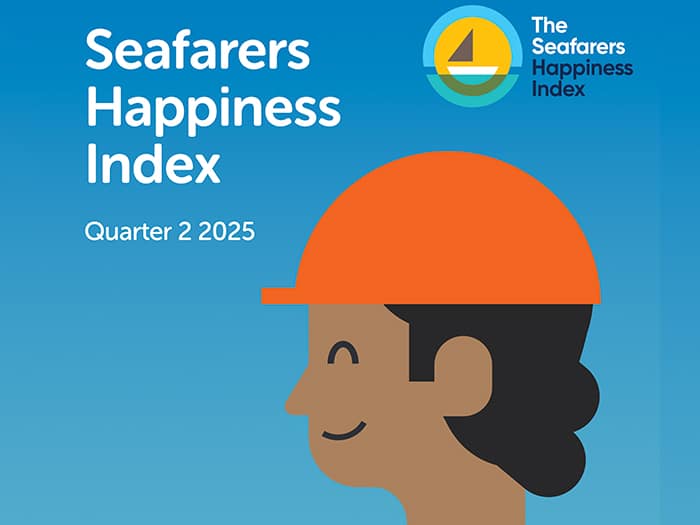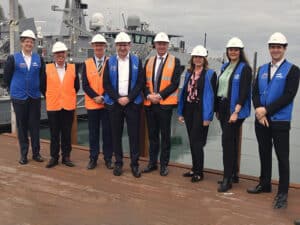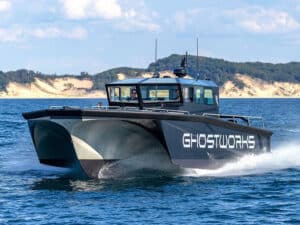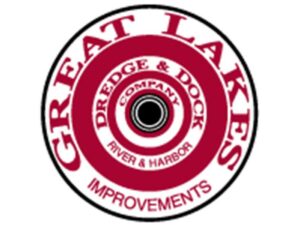
Seafarers’ happiness higher than a few months back, but …
Written by Marine Log Staff
Mission to Seafarers
The Mission to Seafarers says that its just published second quarter 2025 Seafarers Happiness Index, reveals an encouraging uplift in seafarer wellbeing, with the average happiness score rising to 7.54/10, up from 6.98 in the first quarter. Positive trends were seen across all core areas, from connectivity and food to training and wages, painting a picture of a better-supported workforce at sea. Yet despite the improving numbers, seafarers are also sounding a clear and urgent alarm, as safety standards and basic protections are increasingly under threat.
The report revealed that seafarers are finding more day-to-day satisfaction in their roles. Interactions among crews remain the most positive aspect of life onboard. Similarly, connectivity, which is vital for maintaining family ties and mental wellbeing, has continued to improve. Access to reliable internet, even if uneven across fleets, has been life-changing, giving seafarers ability to video call loved ones and enjoy moments of normalcy through entertainment and social connection.
Food quality, health, and exercise have also improved, and there is growing appreciation for fitness facilities and healthier options onboard. Meanwhile, although satisfaction with wages rose, with several respondents noting improvements, concerns persist about deductions and currency exchange losses.
GROWING ANXIETY
Yet these improvements are shadowed by a growing anxiety about physical safety and working conditions. A recurring message is that preventable accidents, such as working at height, entering enclosed space entries, electrocution, and being struck by moving objects, still happen regularly. Despite decades of regulation, technological innovation, and awareness campaigns, seafarers continue to witness or experience dangerous failures.
Particularly concerning is the emergence of new claims related to the misuse of “riding squads” or technician teams. While such crews have historically played a legitimate and vital role in vessel maintenance and specialist repairs, some respondents suggested that certain operators are now using these teams to bypass Standards of Training, Certification and Watchkeeping for Seafarers (STCW) certification requirements, placing non-mariners in operational roles for extended periods. This practice violates regulatory standards, puts qualified seafarers at risk, and undermines trust in the maritime safety framework.
In parallel, seafarers are increasingly critical of the widespread shift to e-learning in place of traditional, hands-on instruction. Seafarers have voiced deep concern that online modules are prioritizing completion statistics over actual competence.
Workload management improved this quarter, yet many described a worrying disconnect between growing demands and stagnant crew resources. Respondents repeatedly pointed to rising paperwork, operational pressure, and reduced shore leave opportunities as symptoms of deeper manning issues. These are not isolated frustrations; they point to systemic strain that may ultimately compromise vessel safety, crew wellbeing, and the wider supply chain.
Despite these serious concerns, there was also clear evidence of pride, resilience, and optimism among crews. Seafarers spoke of their commitment to their work, the strength of onboard friendships, and the quiet professionalism that underpins maritime life. Positive messages about teamwork, encouragement, and faith in the value of their roles were a striking feature of this quarter’s open-ended feedback.
Ben Bailey, Director of Program, The Mission to Seafarers, said: “While the the second quarter 2025 results show real progress, there are some worrying safety concerns that need addressing. As seafarers become more vocal, connected, and engaged, they are raising questions the industry can no longer afford to ignore. The improvement in overall happiness should not obscure the rising concern around safety, training integrity, and manning. Now is the time for industry leaders, regulators, and shipowners to act.”
Thom Herbert, Idwal key account manager and crew welfare advocate at Idwal, commented: “It’s encouraging to see seafarer morale improving in part, with better connectivity, food, and camaraderie making a real difference at sea. But we must listen carefully to the serious concerns around physical safety, misuse of riding squads, and diluted training standards.
“As an industry, we need to work together to uphold conditions that protect crews and support vessel integrity. At Idwal, we see first-hand how these challenges impact operational safety, and we’re committed to being part of the collective effort to raise standards across the board.”
Yves Vandenborn, head of loss prevention Asia-Pacific, NorthStandard, added: “The Seafarers Happiness Index, second quartert 2025 reported an overall happiness score of 7.54/10, up from 6.98 in Q1, a promising trend that reflects improvements in welfare, food quality, workload management, and especially crew interaction. Seafarers expressed appreciation for camaraderie onboard, better gym and food facilities, and more reliable internet enabling family contact. However, despite these gains, persistent challenges remain.
“The results demonstrated that seafarers are keen to explore improved professional development opportunities. Some raised concerns about workload, administrative burdens and shore leave. Pay stagnation and varying food quality in some regions were other factors reported.
“The industry can celebrate positive progress in the overall happiness score but must also remain dedicated to addressing the core concerns highlighted, to ensure long-term seafarer wellbeing and workforce sustainability.”
- To read the full findings from the Seafarers Happiness Index report for second quarter 2025, click HERE




